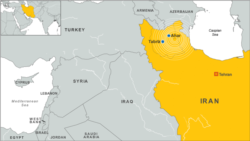Iran said it is now prepared to accept foreign aid for the victims of Saturday's two earthquakes in the nation's northwest.
Iran's state-run IRNA news agency quoted Vice President Mohammad Reza Rahimi as saying Iran is ready to receive contributions from other countries.
Iran earlier rejected offers of outside help from the United States, Germany, Russia, Turkey and other nations. Iran's Red Crescent had said the country did not need foreign assistance and could handle the disaster itself.
On Tuesday, rescue workers recovered more bodies from the ruins of the 6.4 and 6.3 magnitude quakes that killed more than 300 people and injured at least 3,000 others.
 Villages of Tabriz and Ahar, Iran impacted by recent earthquake
A 5.3 aftershock hit one of the epicenters near the city of Tabriz Tuesday, causing some panic among the residents. Officials did not report any casualties.
Villages of Tabriz and Ahar, Iran impacted by recent earthquake
A 5.3 aftershock hit one of the epicenters near the city of Tabriz Tuesday, causing some panic among the residents. Officials did not report any casualties.
The Iranian Red Crescent estimates that 180 villages were damaged in the quakes, with some destroyed near Tabriz.
A spokeswoman for the International Federation of Red Cross and Red Crescent Societies told VOA from Geneva that the group is working closely with Iran's Red Crescent and that they have set up 6,000 tents to accommodate an estimated 16,000 people who are displaced. They are also providing basic supplies and blood donations for the victims.
Earthquakes are common in Iran, but few are significant enough to be noticed. The last major earthquake in Iran was a magnitude 6.6 quake in 2003 in the southeastern city of Bam, where 30,000 people died.
Photo Gallery: Iran Earthquake
Iran's state-run IRNA news agency quoted Vice President Mohammad Reza Rahimi as saying Iran is ready to receive contributions from other countries.
Iran earlier rejected offers of outside help from the United States, Germany, Russia, Turkey and other nations. Iran's Red Crescent had said the country did not need foreign assistance and could handle the disaster itself.
On Tuesday, rescue workers recovered more bodies from the ruins of the 6.4 and 6.3 magnitude quakes that killed more than 300 people and injured at least 3,000 others.
 Villages of Tabriz and Ahar, Iran impacted by recent earthquake
Villages of Tabriz and Ahar, Iran impacted by recent earthquakeThe Iranian Red Crescent estimates that 180 villages were damaged in the quakes, with some destroyed near Tabriz.
A spokeswoman for the International Federation of Red Cross and Red Crescent Societies told VOA from Geneva that the group is working closely with Iran's Red Crescent and that they have set up 6,000 tents to accommodate an estimated 16,000 people who are displaced. They are also providing basic supplies and blood donations for the victims.
Earthquakes are common in Iran, but few are significant enough to be noticed. The last major earthquake in Iran was a magnitude 6.6 quake in 2003 in the southeastern city of Bam, where 30,000 people died.
Photo Gallery: Iran Earthquake









